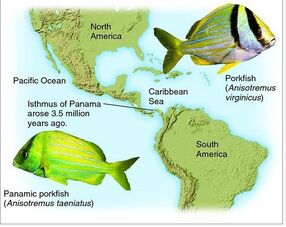Allopatric speciation is speciation caused by geographic isolation which can take two forms: dispersal and vicariance. Dispersal occurs when an organism moves to a new area and starts a new population that is isolated from the population in which it came from. Vicariance is when an organism’s home range is split by a physical barrier (Freeman & Herron, 2007). Physical barriers can consist of things such as rivers, mountains, canyons, or deserts which prevent organisms of the same species from regularly mating with each other. Over time the separated organisms evolve into separate species.
Freeman, S. & Herron, J. (2007). Evolutionary Analysis 4th Ed. Speciation, pp 605 - 633.
The process of allopatric speciation can be seen in a salamander in California. As the population started moving south it was split by the great central valley. Once they passed the valley and came together they looked very different but are still the same species. When the two different color forms breed the result is a color form that not well suited to any habitat and it is believed that in the future the salamander will continue to evolve and become two distinct species. The video explains this process and illustrates the differences in the salamanders.

Speciation

The Isthmus of Panama seems to be a hot spot for allopatric speciation. Another example from class discusses shrimp evolution.